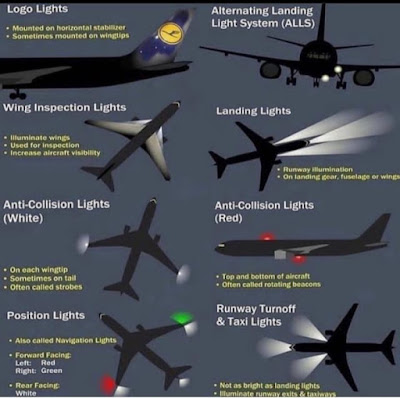Aircraft Lights
Aircraft Lights :
Aircraft Lights systems are provided to illuminate both the exterior and interior of the aircraft. Lights on exterior is known as exterior lights and used for such operations as landing at night, inspection of icing on leading edge of wings and engine inlets, to determine the position of aircraft on air / ground, and safety from midair collision. Interior lights are provided to illuminate instruments, instruments panel, cockpit, cabins, gally, cargo compartment, and passenger compartment. Some special lights are used for indication and warnings and operational status of equipment.Aircraft Exterior Lights :
Aircraft exterior lights are those which are use to illuminate exterior for safe operation of aircraft at night. Followings are the aircraft exterior lights :
- Navigation or Position Lights
- Landing Lights
- Runway Turnoff lights
- Taxi and Takeoff lights
- Logo lights
- Beacon Lights or Anti Collision Lights
- Strobe Lights
- Wing Inspection Lights
Navigation or Position Lights
Navigation Lights are used to position the aircraft on ground or in air. Navigation Lights consist of two sets of light and color coded. Three colors of lights are used in navigation lights such as GREEN O at right wing tip, RED O at left wing tip and AMBER at the tail cone.
Specification of Navigation Lights
- Wing tip lights have an integrated transformer for each and get power of 28 v AC. Power rating of wingtips navigation lights are 50W.
- Tail cone lights have an external transformer and get power of 12v AC. Power rating of tail come navigation lights are 25W.
Landing Lights
Landing Lights are used to illuminate the runway during night landing. Landing lights are powerful and directed by the parabolic reflector at an angle which provide maximum illumination.
Location of Landing Lights : On light aircraft landing lights are located midway of wind on the leading edge of each wing. On large aircraft landing lights are located on the leading edge of the wing near the fuselage or maybe a retractable landing lights ( on A320 series aircrafts).
Landing lights consist of a sealed beam / halogen / high intensity xenon discharge lamp. Landing lights are controlled by relay. On Airbus aircraft landing lights are controlled by THREE POSITION LNG SWITCH ( On , OFF, RETRACT).
Landing Lights have an integrated transformer and get power of 28v AC. Power rating of landing lights is 600W.
Taxi and Takeoff lights
Taxi and takeoff lights are used to illuminate taxiways during takeoff and ground movement such as Taxiing or towing, runway to bay or stand, stand to runway. Taxi lights are not designed to provide enough illumination for landing. Taxi lights are mounted on non steerable parts of nose landing gear and positioned at an oblique angle to the centre line of the a/c to provide illumination in front of a/c.
Taxi and Takeoff lights are controlled by THREE position nose selector ( T.O. : taxi and takeoff lights are on if the NLG is downlocked, TAXI: taxi light is on if the NLG is downlocked, OFF: all lights are off.)
Runway Turnoff lights
Runway Turnoff lights are similar to taxi lights except they are mounted on an angle pointing to the left and right of the aircraft nose. These lights will illuminate taxiways or obstacles on either side of the aircraft. Runway turnoff lights are controlled by two position RNWY TRN OFF sw.
Logo lights
Logo lights are generally mounted on the upper surface of each trimmable horizontal stabilizer and aimed to illuminate the Company logo on the vertical stabilizer of the aircraft. Logo lights are controlled together with Navigation lights.
Logo lights get power of 28v AC and power rating is 150W.
Beacon Lights or Anti Collision Lights
Beacon Lights are also known as Anti Collision lights. Beacon lights are high intensity red flashing lights. Two beacon lights are installed, one on the top of the fuselage and the other on the bottom of the fuselage. The beacon lights are operated alternately in synchronization with the strobe lights. They are supplied and controlled through their related Power Supply Unit (PSU), if the BEACON SW (ON/OFF) is ON.The beacon lights are turned on prior to engine start and turned off after engines have been shut down.
Strobe Lights
Strobe lights are high intensity white flashing lights which flash at regular intervals. Strobe lights are usually positioned near the trailing edge of the wing tips and also be installed on the tail cone. Strobe lights are normally turned on when entering an active runway for takeoff and turned off when leaving the runway after landing. Strobes can also be used to provide additional visibility when crossing an active runway during ground maneuvering.
They are synchronized and operate alternatively with the beacon lights. They are supplied and controlled through their related PSU according to the STROBE switch position (ON/AUTO/OFF).
Wing Inspection Lights
Wing inspection lights are aimed to illuminate the leading edge of the wing and the engine pylons for icing and general condition in flight. These lights are mounted in the fuselage. They are also used during night for aircraft preflight inspection and during engine start.
Wing inspection lights are controlled by WING switch (ON/OFF).


